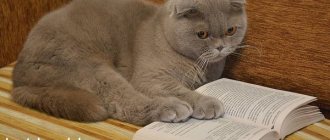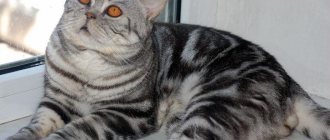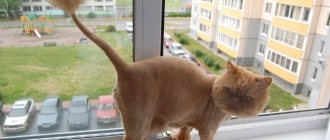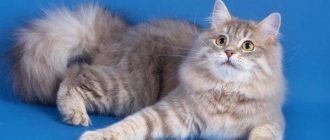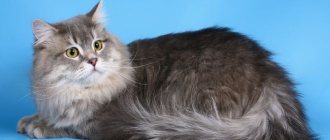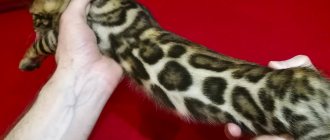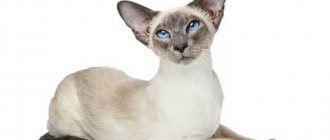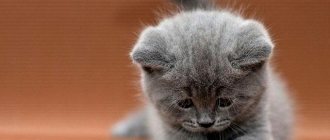Scottish Blue Point cats
The color of blue point Scottish cats (translated from English as “blue-point” means “blue dot”) is very beautiful. These are completely unique shades of light fur - the main color and shading on the paws, muzzle, ears and tail. Many people want to get just such a cat, because she is fabulously cute.
In the photo: Scottish Fold Blue Point
In the photo: Scottish Straight blue point color
The blue point color is associated with the phenomenon of acromelanism - the dependence of the intensity of coat coloring on temperature: in places where the body temperature is higher, the coat is lighter, and vice versa. While colorful kittens are in the mother’s belly, they are completely light, because their body temperature is uniform. But within a few days after birth, Scottish Blue Point kittens begin to darken their paws, tail, face and ears due to the fact that the temperature of these parts of the body is lower than the rest. This effect is associated with the action of the enzyme tyrosinase, which is responsible for the synthesis of pigments. By the way, for the same reason, colorful cats can change color slightly depending on the air temperature - sometimes darker, sometimes lighter. In addition, this color changes with age.
The color gene in cats determines not only the color of the coat, but also the eyes, which remain blue without changing to golden in adulthood. Blue eyes are the dream of almost every cat owner. And the main thing is that in this case the blue-eyed gene is not associated with deafness, as happens in pure white murkies. As a result, we have unique shades of eyes and fur, which, as a rule, are liked by absolutely everyone, even those who can’t stand Chocleate Point cats (“chocolate point”), which are associated with Siamese and create the impression that they stuck their muzzle in chocolate.
Colors
Scottish Straights come in many acceptable colors, and breeders have been trying for many years to diversify their coats and make them brighter. They succeeded, now the standard includes dozens of colors, which are presented in various variations.
Many people like the original “black smoke”, which makes the cat look like a magical creature from the world of magicians; lovers of the classics will like the gray tint, and dreamers will definitely appreciate the snow-white or cream fur.
Colors are divided into solid, smoky, tabby, tortoiseshell, two-color, shaded, harlequin, van, point, chinchilla, ticked. The rarest and most sought after among cat lovers are chinchilla, marbled, and blue point colors. Let's take a closer look at them.
Chinchilla
This is a very impressive type, it resembles silver or black pearl, breeders value it very much. At first glance, the fur seems monochromatic, but upon closer inspection, some sputtering becomes noticeable. This is due to the fact that the ends of the hair are dyed only one-eighth of the length.
There are several options for this color, for example, lilac, chocolate, red, cream. The character of such individuals is calm, peaceful, and friendly. Their eyes must be green. The spraying effect is called ticking, in which the pigment is distributed unevenly throughout the hair, only the tip of the hair is colored, and the rest remains light.
Marble
The color is otherwise called tabby; it comes in silver and golden.
Marble on silver looks very original, while the cat has a thick snow-white undercoat, on which there are charcoal stripes and patterns. The animals resemble cats from Whiskas advertising. These kisuli have a more capricious and proud character than their relatives of other colors.
To read: Elegant and willful dog Toy Terrier: characteristics of the breed and weight of the puppy
Golden fur is very rare and looks luxurious and elegant. On a golden background there are dark, clearly visible stripes in the form of various zigzags, shapes, and stripes. The eyes are usually copper or yellow. Both these and silver Scots have a clearly visible letter “M” on their foreheads, which is made up of stripes.
Blue point
In English this name translates as blue dot. The shade looks great, original and unique. With light hair on the body, there are dark spots with stripes on the paws, ears, tail and muzzle. Such representatives of the breed look fabulous.
A distinctive feature of these cats is that they have a gene that determines both the color of their fur and their eyes, which remain blue throughout their lives. This skin is an inheritance from the Persians and exotics. Breeders value it very highly; there are even nurseries that breed only such four-legged animals.
Blue-point coloring is associated with the production of melanin, that is, the shade depends on the temperature: where it is higher, it is lighter. Babies are born white, but over time they darken in areas where body temperature is lower.
It is important to ensure that they do not lie in drafts, because this can cause dark spots to form on the fur coat, which then cannot be removed with anything. It is believed that blue point cats are calmer and more reasonable than their relatives.
Blue point color standard
A straight-eared or fold-eared Blue Point Scottish cat should have a blue mask on its face and the same markings on its ears, paws and tail. The rest of the body is almost white: without markings or patterns, blurred spots and yellow tones. All this is considered a disadvantage.
A good point color that will last a lifetime is quite difficult to obtain. Small kittens often have high-quality coloring that matches the standard, but as they grow older, the body may darken, which is a big disadvantage.
The ideal point color works well when both parents of the kitten are also points, and not in the first generation. Conversely, there is a greater chance of getting a darkened body if the parents were of a different color, for example, solid (solid).
The eyes of a blue point cat, as we have already said, are blue. The darker, more saturated, “deeper” the color, the better. Cats with light eyes (and often they are not at all expressed, grayish) are valued less.
Colories with decent eye color often have disgusting coat texture and a rustic appearance. The British often have weak bones, the Scots have short, problematic tails and ears that are not laid back well enough. These disadvantages are related to similar problems with shaded colors, which are most often used to produce color points. Yes, there are already some British people with decent hair and decent type, but there are only a few of them. As well as in the colorful colors worthy of the Scottish ones, there are only a few. British colors, obtained from blue, lilac, and patterned animals, most often have good bone and coat. In some places there is even a good contrast, but for the most part they have an extremely pale eye color. Scottish breeds bred from colored stock are also pale-eyed. They have a positive chance only if they are obtained from stable lines imported at different times from the USA and Canada. Local stock bred from the British will produce British-like variants with all the characteristic nuances.
A Brief History of Breeding Cat Colors
Initially, all cats had variegated colors, which allowed the animals to remain unnoticed in the forest. Human intervention has made their color, by which we mean the color of the coat and various patterns on the skin (stains, all kinds of spots, stripes, etc.), extremely diverse. As a result of crossing individuals with certain characteristics, offspring of the desired color appeared. To consolidate the result obtained, only these animals were used in future breeding work; all others were excluded from the breeding process.
There are a lot of colors of cats bred
Blue point color genetics
Point belongs to the black series of colors, because, from the point of view of genetics, blue is nothing more than a diluted, or rather rearranged, black pigment. But blue coat genes B (black series) and d (dilution gene) alone are not enough to get a point kitten. A couple more recessive cs genes are needed, which displace the pigment into the marking area.
The ancestors of the Points are Siamese cats, which is why the color is also called Siamese. In Thailand it is considered sacred because... he was taken out by the monks in the monastery.
Today, among Scottish cats, the color gene cannot be called so rare, but breeders often value its carriers higher than solid blue cats. There are even entire nurseries that specialize in the reproduction of Point cats.
You can get a point cat even if both parents, for example, are gray (that’s what people call them, although they are actually blue). The main thing is that they are carriers of the desired gene. But even if they carry this gene, the chance of having a colored kitten is 25%. It happens that the color gene appears after 2-3 generations. For example, the kitten’s great-grandparents were colorful, but the gene did not manifest itself in the form of color in the parents. At the same time, two color point parents cannot produce a kitten of a color other than color point.
The international designation for the blue point color is a33.
Main breeds
Thai and Siamese cat breeds are precisely those that have the color point pigment initially. This is implied by the standard. But there are other types. In addition to plain coats, they also have point subspecies. These include:
- Persian. This is the first breed that has been successfully turned into a pointing breed, with the exception of the Siamese. The Point Persian was created by mating a Siamese cat with an ordinary Persian cat. But there is also a small minus for the owners - a lot of attention must be paid to the luxurious fur of these pets.
- British colorpoint cats. This is a separate subspecies of ordinary Britons, which was first bred not so long ago. Breeding them is quite a difficult task, so babies of this breed are highly valued.
- Scottish straight. Representatives of this breed have darkened areas that look like a light haze. It was possible to breed by mating the best specimens of the British and Persians. These are very beautiful cats, and they also have a soft and flexible character.
- Neva Masquerade. These are Siberian cats with pigment coloring. They were first bred by St. Petersburg breeders by crossing Siberians and Siamese. The artificially bred breed is extremely beautiful. Its representatives have a rather large body with a very thick coat, which was inherited from their Siberian ancestors. It goes well with the colors of the Siamese, as well as the deep blue eyes.
- This coloring is found in all breeds of sphinxes, for example, Canadian or Peterbalds. They have point coloring on their skin, since the fur is completely or almost completely absent.
This is not the entire list of breeds with this coat color. There are also very rare ones, for example, snowshoe or Burmese. But they are not yet very common in the world.
Scottish Highland Straight
The Scottish Highland Straight is a subspecies of the Scottish cat. It is distinguished by the fact that it has long hair and erect ears. This variety has an unusual color. They brought her out in the 70s. years of the last century, when the British crossed with the Persians. Kittens from these breeds were able to get only the best. They have a very calm and friendly character, as well as a cute appearance. Highland Straights are easy to maintain. There is also a tortoiseshell variety, which also has a point color. Description of the breed:
- Quite long coat that is very easy to comb. Has a relatively dense undercoat.
- The ears are small in size with rounded tips and stand erect.
- The eyes are large and round in shape. Color may vary. He is completely dependent on wool.
- The body is strong, muscular, of medium size. Often these cats have a round shape.
- The toes are quite tightly clenched. The limbs themselves are long.
- The head is round and has a convex skull.
- Average tail length. He is very fluffy and active.
- These cats live from 10 to 20 years.
- The average weight of animals is 3.5 kg, and that of a cat is 5 kg.
- Standard length is 30 cm.
This breed is very flexible. But their main advantage is their tenderness and friendliness. When buying a kitten, you should pay attention to the color, as there should not be white color.
If it is present, then such a pet will not be able to participate in exhibitions.
British Shorthair
There is a well-established opinion that this breed was brought to Great Britain in the first century BC by the Romans. The main advantage at that time was considered to be short and very thick wool. It helped protect cats from excessive moisture, as well as small parasites while hunting rodents. The British breed was very hardy and had good health. They were used as hunters. Only many centuries later they began to be looked at from the point of view of beauty. The first exhibition took place in 1871. Description of the breed:
Strabismus in point cats
Cats of any point color (and there are not only blue, but also seal point, lilac point, lynx point and other variations) can experience convergent strabismus, which is characteristic of cats of the Siamese, Thai, Oriental and Burmese breeds. This defect, geneticists believe, is a byproduct of the action of the cs point gene.
Often in point cats you can find a violation of the projection of the optic nerves: part of the visual pathways from the eye goes to the side of the brain opposite to the norm. To compensate for this feature, strabismus appears, which allows the cat to build the correct visual picture.
Ticked Scottish
These individuals also have spraying, but this time it is achieved by alternating dark tones with light ones along the length of the entire hair. The top is always dark.
The palette can be anything. For example, silver, golden, blue, red.
IMPORTANT: Those who have taken a fancy to such a cat should know that Scottish straights are rare in such a palette, and therefore are expensive.
Such representatives of the cat family should not have a pattern. Stripes and spots are considered defects. But the eyes can be different - most often green, but they can also be yellow or copper.
Blue point color and character
There is an opinion (not a proven fact) that the Blue Point Scotsman is a cat with character. The fact is that the blue colors of the Scots were originally obtained from British cats, known for their temper. Modern Scottish Folds and Blue Point Scottish Straights are somewhat similar in character to the British: they are independent, willful, and can be aggressive if they don’t like something. However, the degree of expression of these qualities depends on the presence of British cats in the immediate family. If there are a lot of British people in the document, you should expect a tougher character, and vice versa. However, British genes will still be softened by Scottish ones, so such cats are more sociable and kinder than their British counterparts.
Calico cats
The variety of Scots with such an interesting name is also commonly called “patchwork turtles.” This turtle can really be called tricolor. The main cover is white. Other shades can be red, black, cream.
IMPORTANT: Such cats are extremely preferable for breeding - they can produce offspring of various shades.
Fun fact: Calicos are believed to be found only among the Scottish Straight breed. It is probably because of their rarity that the belief began that calico cats bring happiness. Or perhaps it’s all about the wonderful character of this animal.
Caring for point cats
In general, care for point cats is the same as for cats of other colors. But it has its own characteristics.
Point cats cannot be cut or shaved: this leads to the appearance of darker areas of the coat. In the photo below you see the “panties” of a point cat, which formed after shaving before sterilization. This feature of this color, of course, does not mean that a Point cat cannot be operated on: a mark on the stomach does not make the animal less beautiful, because it is practically invisible. But, if you trim your cat's entire hair or in prominent places, or shave it, this can cause it to become dark throughout the body, and this will ruin its appearance.
Inept use of a fruminator when combing can also lead to bad consequences, because... With this tool it is easy to damage and cut off hairs, resulting in the undesirable effect of darkening the fur. If you do not know how to use a furminator, it is better to opt for a special paw for combing cats.
Also, the color of the point, as we said above, reacts to the ambient temperature: the lower it is, the darker the marks, and vice versa - in the heat, many cats become significantly lighter. Accordingly, don’t be surprised if your cat looks a little different depending on the time of year. The ideal temperature for keeping points is +25 degrees.
It is worth considering that the blue point color is a light color, and therefore easily soiled: dust and dirt in the house, settling on the fur, will spoil the appearance of the cat. Even if she is washed regularly, you will notice that the color becomes more interesting after a bath. This statement is not a call to endlessly bathe your pet, but advice on how you can improve the color if you suddenly notice that it has worsened. If the cause was contamination, advice will help. Although there are many other reasons for the deterioration of color point colors.
To improve the color, you can bathe Blue Point cats whose bodies are not light enough with special lightening shampoos. However, if the cat’s markings, on the contrary, are weakly expressed, then there is no need to lighten the fur further. Then you can choose any shampoo based on the problem (if any) or a basic one. We are talking about professional shampoos. It is better to avoid mass-market shampoos.
Some owners notice that food also affects the color of Blue Points: beef, carrots, beets, liver and seaweed can darken the coat. However, this has not been scientifically proven, and along with the owners who noticed changes in color depending on the diet, there are those who do not see any changes.
In the end, we would like to add that the point color of Scottish and British cats is one of the most unstudied: probably, its quality is influenced by a greater number of genes than is currently known to felinologists. So far, among the British and Scots, standard-colored point cats that have retained the excellent morphological characteristics inherent in these breeds are a rarity. The point colors within these breeds will still undergo changes: breeders have a lot of work ahead of them.
Source
Chinchillas
Just like the smoky cat, it has partially dyed pile. Only if the last representative of the cat family has silvery roots, the chinchilla, on the contrary, is characterized by almost completely white hair. Only 1/8 of the cover is colored. Due to this, the animal’s fur coat seems to have a sputtering effect.
IMPORTANT: Such cats always have a dark outline around the eyes, nose, and lips.
The eyes themselves have a stunning green tint. The nose and paw pads are most often pink.
When it comes to base coverage, there are plenty to choose from. Experts count at least a dozen colors of chinchillas. For example, this is cameo, cream, chocolate, lilac, blue. The most rare is the golden-blue chinchilla.
The character of such animals is also calm. But at the same time, they are not averse to actively playing or showing character from time to time.
What to feed a Scottish kitten?
Scottish cats are very fluffy and cute, many people dream of having such a pet. Their skin comes in different colors, from marbled to point. Scottish Straights (straight-eared Scots) originated in Scotland, as can be understood from the name. Only recently has the breed gained independence, because there is also a fold-eared variety. Such a kitty will bring a lot of positivity and joy to any home. She will get along well with small children, will not bite or scratch them, will gladly take part in games and fun, and when she gets tired, she will simply hide in her house. By the way, she needs a house - it is important that the animal has a place where it can retire and be in peace and quiet, without communicating with anyone and gaining strength.
Tabby
The most common group of Scottish coat colors, which is further divided into subcategories:
- shaded - marble coloring;
- mackerel - tiger coloring;
- spotted - spotted coloring.
As for color variations, the tabby is represented by the following:
- silver (black pattern on a cold steel background);
- cameo (bright carrot stripes on a white background);
- silver-blue (gray pattern on a cold steel background);
- cream (dark beige pattern on a delicate cream background);
- red (bright red pattern on a warm peach background);
- blue (rich gray pattern on a silver-beige background);
- cinnamon (black design on a copper background).
Photos of Scottish tabby cats:
Description
These animals have the following appearance features:
- weight about five kilograms for boys and three and a half for girls,
- rounded head shape,
- elongated graceful body,
- graceful plastic movements, mobility,
- forehead is convex, high, rounded,
- eyes wide apart, open, large, expressive,
- round muzzle, developed chin,
- Medium length and width of the paw, harmoniously combined with the body,
- the tail can be long and very long, tapering at the tip,
- The nose can be either medium or short. It is wide and with a recess,
- very soft, thick undercoat, hair does not fit tightly to the body,
- fur can be both short and long,
- The ears are small or medium-sized, rounded at the tips and wide at the base.
Determination of color
Color point is a derivative of a combination of two English words: color (color) and point (point). Its visual expression is characterized by the contrasting difference between the light body of the animal and the accentuated ends of the limbs.
The most typical representative of this class is the Siamese breed, from which, apparently, the entire selection line came.
The distinctive features of the color point color appear as follows:
- light monochromatic hair on the body;
- clearly visible darkening on the legs, tail and ears;
- a contrast mask on the muzzle that can spread over its entire surface or be located only in the nose area.
The color of the limbs and its saturation depend on additional reasons.
Interesting: All colorpoint kittens are born without signs of future pigmented areas, but they appear already in the first week of life.
Variations
Colors are divided into three groups: solid, tortoiseshell and tabby. In the first case, the marks have a uniform shade without foreign inclusions. Tortoiseshell implies the presence of heterogeneous spots (a combination of red, brown, blue, cream colors), this type is found only in female animals.
Blue tabby point
Tabby cats have distinct stripes on their fur. There must be a pattern on the forehead resembling the letter M.
The color of the entire body is solid; there are also markings on the paw pads.
- blue – the body has a slightly bluish tint, the markings are gray or blue;
- seal – dark brown markings, cream body fur;
- chocolate or choklit - spots of rich milk chocolate color, body color - white or slightly creamy;
- cream – soft cream, body slightly lighter than the spots;
- red – the spots have a red (rich red) color, the body is cream or light apricot;
- lilac – the fur on the body is white, the markings are purple;
- cinnamon – cinnamon-colored spots, beige body;
- faun - the fur on the body is beige (almost white), the spots are light purple.
Tonkinese Fawn Point kitten is classified as tortoiseshell (the first word in the name is the main color of the spots, the second word is the color of the inclusions): Tortoiseshell color of a British cat Among tabbies there are various variations. The word tabby must be added to the name.
Character
Such pets have high intelligence, they have an easy-going character, they are self-sufficient and reasonable. They tend to choose one of the family members, whom they consider their master, but they also love the rest very much, but they don’t sit in anyone’s arms. It’s better for the cat to sit next to you and press its side to the person.
Kids easily get used to a new home and other pets; they are quite comfortable with children and older people. They tolerate loneliness well. When everyone is at work, they don’t destroy the house and behave well. These are very obedient animals, they understand well what is possible and what is not. They are active, love to play, but always know when to stop.
Pets almost never use their claws or teeth; if you get too hard on them, they will rather go into a corner and hide there. They cannot stand rude treatment; if you yell at them, they can hide for a long time and not come out, getting offended. If you decide to explain to the purr that he did something wrong, it is better to just speak in a stern voice. This is enough, because he is smart and understands everything.
Color Point (Not Siamese)
What breed is this cat? Probably 90% of people who are far from felinology in general and cat breeding in particular will answer without hesitation - Siamese. Is this really so?
Unfortunately, a common mistake of many lies in transferring the name of the color characteristic of the Siamese and Thai breeds to all color-point cats.
What is this color point color and why is it called that?
Siamese cats have a lighter colored body than the protruding parts of the body - the points (muzzle, ears, paws and tail), which are more intensely colored. Therefore, this color is called “point”, that is, terminal.
Color point belongs to the group of acromelanic colors. Acromelanism is a phenomenon of incomplete albinism, when the intensity of coat coloring depends on temperature (!) - less pigment is produced in warm parts of the body than in cold ones, that is, on the ears, muzzle, paws and tail, which will be colored darker.
These individuals do not require special conditions and are very easy to maintain. They live well in apartments and do not need much space. When leaving home, be sure to leave your pet toys, food and water. Then he will survive this time well. Grooming for Scots is standard; you need to regularly trim their nails, wash their eyes, clean their ears, and comb out their fur. The latter should be done about once or twice a week, bathing rarely, as it gets dirty.
It is very important to love your pet and show him that he is important. In this case, he will feel great and live a long and happy life. Don't forget to monitor his health and give him medications for worms and fleas. Even a pet can become infected with them. If you plan to take him outside, it is better to get a harness to control his movement. He tolerates travel and travel very well and feels comfortable in the car.
Bicolor options
Bicolor is a two-color option. That is, a kitten or an adult must clearly have two shades. By the way, such colors are rare. However, she is very loved among admirers of the cat family, since such pets are extremely attached to their owner, restless, and always ready to play.
So, what palette is combined in such animals? Most breeders assure that white must certainly be present, and in addition to it there is another shade. For example, cream, blue, red, black, even tabby. Other breeders allow the absence of white - for example, in black and red variations.
IMPORTANT: In any case, the tummy, paws and muzzle should be painted in a lighter tone.
It is preferable that the drawings are located symmetrically in relation to each other. However, this is not a necessary condition.
The standard does not exclude multi-colored eyes. They can also be heavenly, amber. There are individuals with green eyes.
Caring for a cat with point colors
Experienced breeders recommend paying special attention to cats with this color. The optimal air temperature is 25-28 degrees. When it sharply decreases, the fur will darken; when it increases, the marks will become lighter.
It is not advisable to add foods containing iodine and copper to your diet.
Thai cat with point colors
Long-haired cats need to be brushed daily. If matted hair has to be cut, darker hair will grow in its place.
Blue point cats, which appeared not so long ago, quickly won the love of breeders for their unusually beautiful colors. Those wishing to purchase a kitten of this noble shade have a choice of breeds and variations.
Caring for a Blue Point pet is not much more difficult than caring for any other cat.
If you decide to buy a baby with blue markings, I wish you good luck in raising him and joy in your future life with him.
Yes, the Scottish Fold is not the most capricious breed; they are quite independent and can be alone for some time without hysterics. They do not accept excessive activity on the part of humans, shy away from overly intrusive children and do not welcome fuss and noise.
We suggest you read: Choosing food for Scottish Fold
They love to be around people. They enjoy watching everything that happens in the house. They can follow on your heels, but not give in to your hands.
Point colors of the Scottish Straight cat
This color is often called “Siamese” by cat lovers. The main characteristic of the Point is that the legs, tail, ears and muzzle are darker than the main coat. The following variations are allowed:
- Blue point - as the name implies, there are blue marks in the areas indicated above. It is preferable that the blue is not very dark. The main coat is white.
- Cream point is a completely cream color. Only the main part of the fur coat is painted in a lighter shade, and individual parts are painted in a darker shade.
- Cream Blue Point is a rather interesting variation, in which the body is grayish-cream, and the muzzle, paws, ears and tail are dark gray.
- Lilac Point – there are purple markings on the snow coat.
- Chocleate Point is a very beautiful color, in which specks of a rich chocolate palette adorn the snowy coat.
- Chocolate Smoke Point – a whole scattering of chocolate! The main surface of the fur coat shimmers with a light variation of brown, and the remaining necessary areas are dark.
- Red point - the white cover is marked with red areas.
- Tortie point - in simple words, it is a tortoiseshell color mixed with cream or red spots.
- Tabby point - light coat marked with striped areas in the right places.
Whatever the point variant, the eyes should in any case be colored blue.
These cats are extremely careful and reasonable. Cleanliness is also their calling card.
Plain Scottish
The solid color is considered the most common among the Scots. Whatever it is, it must be rich and uniform. Interspersed with other shades mean that either the kitten belongs to a different color type, or it does not meet the standard.
So, a Scottish solid color pet could be as follows:
- Gray – or, as it is most often called, “blue”. This color of the Scottish Straight is perhaps the most common. Representatives of this clan have a dark gray fur coat. They are very similar to the British, but, according to fans of this breed, they look more elegant. Their paw pads and nose are the same blue color as their fur. The eyes are amber in color. By nature, such a cat is most often melancholic.
- White – the fur of these animals has a pure snow tone. The fur coat seems to shimmer in the light. The nose and paw pads are pink. The eyes of a white animal can be blue, amber or even multi-colored. The cat's disposition of such pets is distinguished by affection and calmness.
- Black - despite the fact that the color itself is quite rich, grayish or red tints are allowed. The paw pads and nose are completely blended with the main color. Against the background of this black mystery, amber eyes should stand out brightly. A black cat is usually friendly to its own people, but wary of strangers.
- Lilac is a very smooth transition from a soft gray shade to cream. This palette was not easy for breeders, but today lilac cats can still be found quite often. Both their paws and nose are identical to the main color. Amber eyes also harmonize perfectly against the general background. This straight-eared animal has an independent character.
- Brown – also known as “chocolate”. It has fur of a rich chocolate color. The nose and paw pads have a tone similar to the fur coat. The eyes are amber. It is noted that the character of such cats is very affectionate.
- Cinnamon is a shade of cinnamon. A kind of variation of brown. But lighter than in the previous case. Another must-have distinguishing feature: this straight has lighter pads and nose. They are brownish-pink as standard.
- Cream – the fur coat, accordingly, has a light cream tone. The eyes, like those of most of the above-described representatives of the breed, are amber. But the nose and the underside of the paws are bright pink.
British cat Blue Point BRI a 33: color standard
The body of a British Blue Point cat should be very light, from cold white to gray-bluish. The point markings should be blue.
In this color it is important to maintain contrast, since the blue tone itself is quite light, so when mating it is important to choose the right partner in order to maintain the richness of the point marks.
The eye color of British Blue Point cats is blue or blue, but again you need to monitor the brightness and intensity of the blue eye color in order to maintain contrast.
The nose and paw pads are gray-blue.
With age, Blue Point British cats gain color and the color becomes more intense, often darkening.
Harlequin
The name was given because the owner of the color is similar to a harlequin. The main color of the coat is white. And only ⅕-⅙ of the body area are colored spots. They are not concentrated in one area, but can be scattered throughout the body.
Photos of harlequin cats:
Features of mating British blue point dogs
The bluepoint color is quite difficult to breed, since the cs gene is recessive (suppressed). Only when both producers (male and female) have such pigment colors, the kittens in the litter will be guaranteed to be pointing only. Parents with smooth, monochromatic hair who are carriers of the cs gene can also produce children with Siamese pigmentation, but with a 25% chance. If a Blue Point female or male is bred with a carrier of the gene, half of the kittens are born white and then acquire the characteristic blue markings.
Source
A little about genetics
It is especially interesting how the color of a Scottish kitten is formed and what it depends on. In the genome of this breed, two colors predominate, responsible for the color of the animal - red and black. Anyone can, under certain conditions beyond a person’s control, become dominant. Such a gene suppresses weak ones, which are called recessive. There is also a third gene, the so-called diluent. It is responsible for the degree of pigmentation saturation.
When these genes are combined with each other, the most unusual coat colors of an animal can appear. It is extremely difficult to determine in the first weeks what color a kitten will have in the future. The shade he was born with is not constant and may change as he grows older. In some cases, dramatic changes occur. The change in shade begins at six months and lasts up to two years. The table below shows options for crossing the colors of parents, according to which their offspring inherits the coat color.
How the coat colors of the offspring are crossed.
Material on the topic: how to get a Scottish fold cat.
